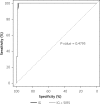Immature granulocytes predict severe acute pancreatitis independently of systemic inflammatory response syndrome
- PMID: 28702104
- PMCID: PMC5497134
- DOI: 10.5114/pg.2017.68116
Immature granulocytes predict severe acute pancreatitis independently of systemic inflammatory response syndrome
Abstract
Introduction: Early prediction of severity of acute pancreatitis (AP) by a simple parameter that positively correlates with the activation stage of the immune system would be very helpful because it could influence the management and improve the outcome. Tumor necrosis factor α (TNF-α) and interleukin-1 (IL-1) play a critical role in the pathogenesis systemic inflammatory response syndrome (SIRS) and severity of AP. One of the effects of IL-1 and TNF-α is an increase in the number of immature granulocytes (IGs) in the peripheral blood.
Aim: To assess whether the IGs% in plasma could be an independent marker of AP severity.
Material and methods: A cohort of 77 patients with AP were prospectively enrolled in the study. The IGs were measured from whole blood samples obtained from the first day of hospitalization using an automated analyser.
Results: We observed 44 (57%) patients with mild AP, 21 (27%) patients with moderate severe AP (SAP) and 12 (16%) patients with SAP. The cut-off value of IGs was 0.6%. The IGs > 0.6% had a sensitivity, specificity, and positive and negative predictive value of 100%, 96%, 85.7%, and 100%, respectively (area under the curve (AUC) = 0.98). On admission, SIRS was present in 25 (32%) patients. We found that in patients who fulfilled at least two criteria for SIRS, SAP could be predicted with 75% sensitivity and 75.4% specificity, positive predictive value 36%, negative predictive value 94.2%.
Conclusions: The IGs% as a routinely obtained marker appears to be a promising, independent biomarker and a better predictor of early prognosis in SAP than SIRS and white blood cell.
Keywords: acute pancreatitis; immature granulocytes; prediction; systemic inflammatory response syndrome.
Figures
Similar articles
-
[Predictive value of immature granulocytes for persistent systemic inflammatory response syndrome in patients with acute pancreatitis: analysis of 1 973 cases].Zhonghua Wei Zhong Bing Ji Jiu Yi Xue. 2018 Dec;30(12):1123-1127. doi: 10.3760/cma.j.issn.2095-4352.2018.012.004. Zhonghua Wei Zhong Bing Ji Jiu Yi Xue. 2018. PMID: 30592943 Chinese.
-
Interleukin-6 significantly improves predictive value of systemic inflammatory response syndrome for predicting severe acute pancreatitis.Pancreatology. 2018 Jul;18(5):500-506. doi: 10.1016/j.pan.2018.05.002. Epub 2018 May 14. Pancreatology. 2018. PMID: 29779831
-
Amalgamation of systemic inflammatory response syndrome score with C-reactive protein level in evaluating acute pancreatitis severity in children.Scand J Gastroenterol. 2018 Jun;53(6):755-759. doi: 10.1080/00365521.2018.1459825. Epub 2018 Apr 12. Scand J Gastroenterol. 2018. PMID: 29644912
-
Soluble urokinase-type plasminogen activator receptor (suPAR) in patients with acute pancreatitis (AP) - Progress in prediction of AP severity.Pancreatology. 2017 Jan-Feb;17(1):24-29. doi: 10.1016/j.pan.2016.11.005. Epub 2016 Nov 25. Pancreatology. 2017. PMID: 27914940
-
Targeting MicroRNA Function in Acute Pancreatitis.Front Physiol. 2017 Sep 21;8:726. doi: 10.3389/fphys.2017.00726. eCollection 2017. Front Physiol. 2017. PMID: 28983256 Free PMC article. Review.
Cited by
-
Neutrophil subsets and their differential roles in viral respiratory diseases.J Leukoc Biol. 2022 Jun;111(6):1159-1173. doi: 10.1002/JLB.1MR1221-345R. Epub 2022 Jan 18. J Leukoc Biol. 2022. PMID: 35040189 Free PMC article. Review.
-
Hematological Indices Predicting the Severity of Acute Pancreatitis Presenting to the Emergency Department: A Retrospective Analysis.Cureus. 2021 Jul 30;13(7):e16752. doi: 10.7759/cureus.16752. eCollection 2021 Jul. Cureus. 2021. PMID: 34513375 Free PMC article.
-
Evaluation of Hemogram Parameters in the Diagnosis of Pulmonary Embolism: Immature Granulocytes and Other New Tips.Clin Appl Thromb Hemost. 2024 Jan-Dec;30:10760296241227212. doi: 10.1177/10760296241227212. Clin Appl Thromb Hemost. 2024. PMID: 38348584 Free PMC article.
-
The role of immature granulocyte in the early prediction of acute perforated and nonperforated appendicitis in children.Ulus Travma Acil Cerrahi Derg. 2022 Mar;28(3):375-381. doi: 10.14744/tjtes.2021.41347. Ulus Travma Acil Cerrahi Derg. 2022. PMID: 35485560 Free PMC article.
-
Update on the effect of age on acute pancreatitis morbidity: a retrospective, single-center study.Prz Gastroenterol. 2018;13(3):223-227. doi: 10.5114/pg.2018.75677. Epub 2018 May 9. Prz Gastroenterol. 2018. PMID: 30302167 Free PMC article.
References
-
- Banks PA, Bollen TL, Dervenis C, et al. Classification of acute pancreatitis--2012: revision of the Atlanta classification and definitions by international consensus. Gut. 2013;62:102–11. - PubMed
-
- Sinha A, Cader R, Akshintala VS, et al. Systemic inflammatory response syndrome between 24 and 48 h after ERCP predicts prolonged length of stay in patients with post-ERCP pancreatitis: a retrospective study. Pancreatology. 2015;15:105–10. - PubMed
-
- Kumar A, Chari ST, Vege SS. Can the time course of systemic inflammatory response syndrome score predict future organ failure in acute pancreatitis? Pancreas. 2014;43:1101–5. - PubMed
-
- de-Madaria E, Banks PA, Moya-Hoyo N, et al. Early factors associated with fluid sequestration and outcomes of patients with acute pancreatitis. Clin Gastroenterol Hepatol. 2014;12:997–1002. - PubMed
LinkOut - more resources
Full Text Sources
Other Literature Sources
Miscellaneous


